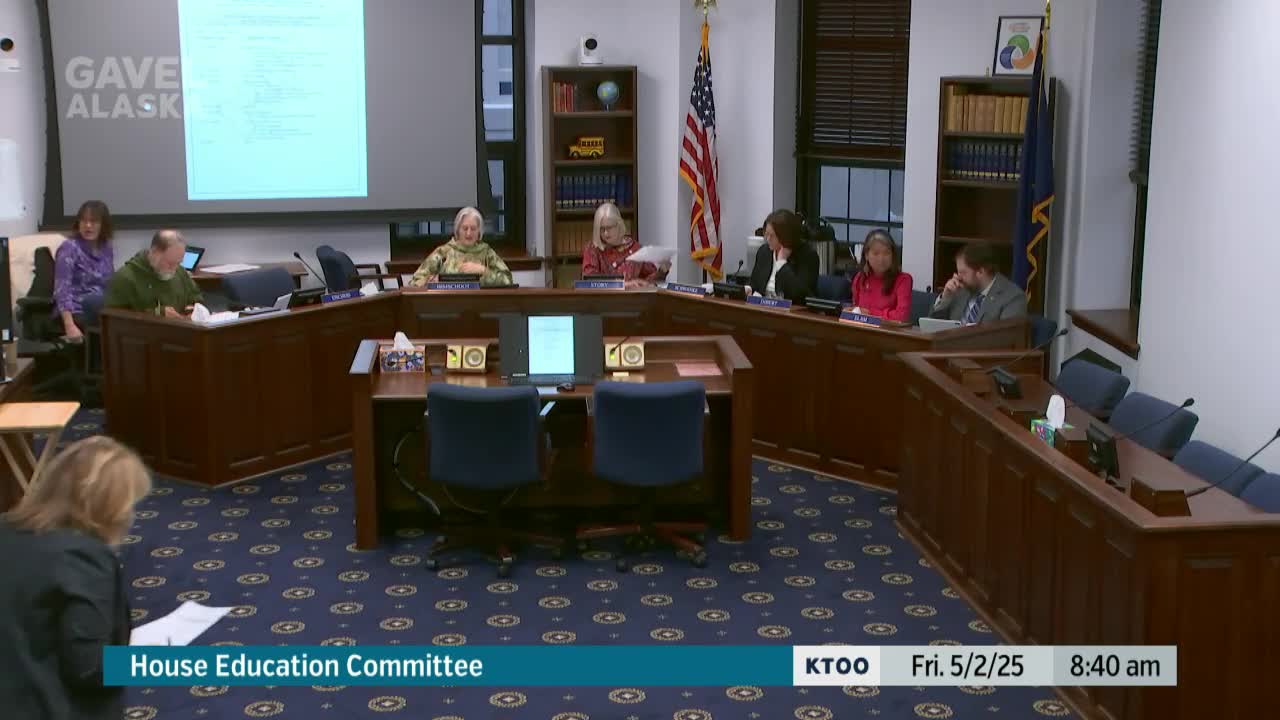Berger Committee reviews capital improvement projects for Alaska schools
May 02, 2025 | 2025 Legislature Alaska, Alaska
This article was created by AI summarizing key points discussed. AI makes mistakes, so for full details and context, please refer to the video of the full meeting. Please report any errors so we can fix them. Report an error »

In a recent meeting of the Alaska Legislature's House Education Committee, the focus turned to the vital work of the Berger Committee, formally known as the Bond Reimbursement and Grant Review Committee. This committee, which plays a crucial role in overseeing school construction and maintenance projects across the state, convened for a two-and-a-half-day session to discuss its priorities and findings.
Heather Heineken, the finance director for the Department of Education and Early Development, joined the meeting virtually to provide insights into the committee's recent activities. She emphasized the committee's diverse membership, which includes professionals from engineering, architecture, and education, ensuring a balanced representation of both urban and rural perspectives. This blend of expertise is essential for making informed recommendations on capital improvement projects and grant applications.
During the meeting, Heineken outlined the committee's responsibilities, which include reviewing capital improvement project priorities, establishing criteria for cost-effective school construction, and recommending changes to the school construction approval process. The committee's work is guided by statutory requirements, ensuring that their recommendations align with state goals for energy efficiency and long-term cost reduction.
The committee's recent agenda was packed with significant items, including the review of 18 school construction requests totaling $349 million and 83 major maintenance projects estimated at $272 million. Heineken noted that the committee also presented the annual SB 200 and SB 237 report to the legislature, which provides a comprehensive overview of the state’s school facilities.
A key highlight from the meeting was the discussion of the REA and small municipal fund, which currently holds approximately $22.8 million. This fund is designated for school construction in rural and small municipal districts, and it is expected to cover the initial projects on the construction list, showcasing the committee's commitment to addressing the needs of underserved areas.
As the meeting concluded, the committee's ongoing efforts to enhance Alaska's educational infrastructure were clear. With a well-rounded team and a structured approach to project evaluation, the Berger Committee is poised to make impactful decisions that will shape the future of school facilities across the state. The discussions held during this meeting not only reflect the committee's dedication but also highlight the importance of collaboration in fostering educational growth in Alaska.
Heather Heineken, the finance director for the Department of Education and Early Development, joined the meeting virtually to provide insights into the committee's recent activities. She emphasized the committee's diverse membership, which includes professionals from engineering, architecture, and education, ensuring a balanced representation of both urban and rural perspectives. This blend of expertise is essential for making informed recommendations on capital improvement projects and grant applications.
During the meeting, Heineken outlined the committee's responsibilities, which include reviewing capital improvement project priorities, establishing criteria for cost-effective school construction, and recommending changes to the school construction approval process. The committee's work is guided by statutory requirements, ensuring that their recommendations align with state goals for energy efficiency and long-term cost reduction.
The committee's recent agenda was packed with significant items, including the review of 18 school construction requests totaling $349 million and 83 major maintenance projects estimated at $272 million. Heineken noted that the committee also presented the annual SB 200 and SB 237 report to the legislature, which provides a comprehensive overview of the state’s school facilities.
A key highlight from the meeting was the discussion of the REA and small municipal fund, which currently holds approximately $22.8 million. This fund is designated for school construction in rural and small municipal districts, and it is expected to cover the initial projects on the construction list, showcasing the committee's commitment to addressing the needs of underserved areas.
As the meeting concluded, the committee's ongoing efforts to enhance Alaska's educational infrastructure were clear. With a well-rounded team and a structured approach to project evaluation, the Berger Committee is poised to make impactful decisions that will shape the future of school facilities across the state. The discussions held during this meeting not only reflect the committee's dedication but also highlight the importance of collaboration in fostering educational growth in Alaska.
View full meeting
This article is based on a recent meeting—watch the full video and explore the complete transcript for deeper insights into the discussion.
View full meeting
